...to you and yours!
Keep 'em flyin'!
I thought it was high time that I should sit down and write an update post on the 2022 model rocket binge build. So here goes:
There is no update !
The truth is, I barely even touched a model rocket during the entire month of October, except perhaps to move a few parts and assemblies around to make room for other projects. I did manage to find the time to glue a couple of fins on the Deltie Airshow booster rocket.
And then there was the model prep for the October 31 launch at Dove Valley.
There were actually several good reasons for this inactivity during October.
First, the initial two weeks were spent in Maryland to visit family there. I had hoped to make a side trip to visit Goddard while I was in the vicinity, but that didn't come to fruition.
In mid-month, I had a request from my oldest grandson to help him build a really cool slingshot he wanted.
So, the rockets got pushed aside and the BlastFromThePast shop transformed into woodworking mode.
I did happen to binge on one thing during the month - all of the new Star Wars series that hit Disney +.
As an aside, if any of you readers are SW fans, don't miss the Andor series. It's really good, in my opinion.
Here's a tip for watching this one - most of the actors speak in thick British, Irish, or Scottish accents, plus the audio level is very low through a lot of it. If you want to even begin to follow any of the dialogue, I strongly advise kicking on the closed-caption feature on your TV.
Anyway, back to rockets.
I seriously don't anticipate November to be much better in terms of getting a lot of work done on the build pile. I've already started unpacking and testing the massive amount of Christmas lights for the annual outdoor decorating project, so the shop has again transformed into 'Electrical Central'.
So, it is quite likely that the current pile of rocket projects will become the "2022-23 Semi-Binge Build".
I'll let you know if I happen to find time to glue up a fin or two.
Perhaps even a launch lug.....
That's the title of a traditional old Irish sea shanty folk song.
In my case, the wording can be changed to:
"What Shall I Do With An Unstable Super Shot?"
In my previous post covering the October 31st launch at the Dove Valley field, I described the flight of such a model rocket.
Flying on a C6-5 motor, the "shot" wasn't quite so "super".
The bird left the pad, cartwheeled wildly in the air, and executed a perfect lawn dart.
This particular model was built back in the late 90s by a friend in Colorado Springs. He and his kids had gotten into model rocketry back then, but lost interest. In 2020, he gave me his collection of built models and several unbuilt kits.
Curious as to why an E2X kit that is supposedly engineered for good flight performance would go so far astray, I pulled out the instruction sheet for the model to see if there was anything missing or if C6 motors were not recommended.
The first thing I looked for was any mention of clay weight for the nose. There was none, and the illustrated kit parts list did not include any either.
Next was the recommended motor list.
Yep. There it was: C6-5 and C6-7 motors were included!
Hmmm ..
So, what am I to do with this model? I normally don't concern myself too much with delving into the performance of mostly-plastic beginners' models, but this one has piqued my interest and put me into 'engineering efficiency' mode.
Subsequently, I have identified several courses of action I could take with the Super Shot:
1. Do nothing. This would mean limiting the model's flights to A and possibly B motors without encountering stability issues. Up until last week, I had only flown this bird on A8 motors. 125 feet max. Ho-hum! At this juncture, I would have to run stability calculations before even trying it on B6 power.
2. Tamp in some nose weight. This would be the easiest of all the choices. At least it would move the CG forward enough to take care of the stability problem, allowing the use of full power. The only issue here is that doing this would add more weight to an already heavy model rocket.
3. Build a payload section. This would require a bit more effort. The problem here is the model uses none of the standard Estes body tubes. The Super Shot's tube measures an inside diameter of 26mm, slightly larger than BT-50. I would need to either roll a tube or find a vendor that carries a similar size. I do have a plastic tube coupler that originally came with the kit. At least I would have a workable payload bay to carry an altimeter or whatever.
Another viable option would be to turn a balsa reducer to facilitate use of a BT-50 or BT-20 tube. Not overly difficult.
4. If I wanted to go completely off-the-wall, I could convert the bird into a fun egglofter. It wouldn't be much of a stretch to use the aforementioned tube coupler with a plastic Easter egg epoxied on. Heck, I haven't flown an egg in a rocket since the HOTROC -4 regional contest in 1983!
5. Ditch the kit nose cone and use the rocket as a first stage booster for multi-staging. All that would be needed is an adequate inter-stage adapter.
So, it's time to get busy on this project. I'll put up a post here on the blog when I get the final version completed.
Cheers!
What could be better than launching model rockets on Halloween?
Launching model rockets in near perfect weather on Halloween, of course.
Today's weather in the Metro Denver area proved to be very mild, with temperatures in the lower 60's and minimal windspeed levels.
Unfortunately, the launch had to be announced early in the morning, so the majority of our Front Range group of rocketeers found it too short of notice to be able to attend. As a result, only two of us were free to make the trip to Dove Valley - Jim Gazur and myself.
I started things off with a launch of my Estes Lynx. This flight marked a milestone in my model rocketry 'career' - the 200th flight of my BAR era. What better model to use than the first that came off the workbench when I resumed my 33-year hiatus from model rocketry!
Powered by an A10-3T motor, the model's 12th flight was picture perfect.
My next model to fly was the ol' Generic E2X.
Carrying a payload section containing both an Estes altimeter and a FlightSketch Mini, the model turned in a great flight on C6-5 power.
Jim Gazur's first flight of the session was the "Snowbird" on an Estes E12-4. Here is Jim's description of this rocket:
The Snowbird popped its parachute and came in for a nice landing near the launch pads.
Since the wind was at a minimum, I deemed it appropriate to try out a boost/glider. Out of the tote came the Flatcat.
Flying on a B4-2 motor, the bird boosted to a respectable altitude. Strangely, during coast phase the model's trajectory described a wide climbing circle. I had never seen this bird exhibit such behavior on past flights. It was usually straight up to apogee.
Nevertheless the model popped its parachute which hung up on the glider. Red Baron!
The Flatcat still descended rather slowly so there was no damage to any of the components.
Next, Jim brought out his big gliders.
The first to hit the skies was his Mini-Dart 2 Radio Control Rocket Glider conversion of a Discus Launch Glider.
The model flew on a Quest black powder C6-3.
In Jim's words: "I had been fighting elevator trim issues on this bird so I decided to ditch the moveable flaps and set everything neutral. The first flight was better in pitch but now there was a roll issue. Luckily the model slowed enough before hitting the ground that there was no damage."
Next up for my fleet was the Cherokee-E.
Flying on a D12-5, the model boosted to a very high altitude. Parachute deployment was perfect and the bird drifted down well within the park boundaries. I still haven't tried this one with an E motor yet - that might have to wait until I can get it to a larger field than Dove Valley.
Today, I had brought along a few smaller models that hadn't seen any air-time for awhile. The first of these was an Estes Super Shot - the 1990s version.
Flying on C6-5 power the model boosted great - until it reached the end of the launch rod!
After that it described cartwheels in very unstable flight across the Colorado blue, after which it dove in and took a core sample outside the launch area. The ejection charge blew the rocket off of the half-buried nose to end a wild and amusing flight.
Much to my surprise, the model sustained no damage whatsoever. Not even a scratch on the body tube. Later this week I must investigate why an Estes E2X model would go unstable in that manner.
Soon Jim had his MD-2 glider prepped and on the pad for its second flight of the day.
"The second flight boosted pretty well with some elevator input, but the glide revealed the need for a different flight condition setting for glide elevator trim. Regardless, I'm happy I finally made some progress on achieving a viable boost."
The other glider that Jim brought to fly this day was a Hawk Radio Control Rocket Glider conversion of a Discus Launch Glider, very similar to the MD2. He flew this one on on an Aerotech C3.4 18mm reload.
My final flight of the day went to the Griffin-2.
Carrying the Estes altimeter, the model boosted very straight and high on a C6-5 motor. The parachute deployed, bringing the model down unscathed after a little over a minute. The altimeter claimed 831 feet altitude.
With that done, Jim and I packed up and turned our footsteps homeward, having put up ten flights between us.
Even though two of my six flights were mishaps, none of the models flown today are destined for the 'repair shelf' back at the shop.
I'll take that any day...even on Halloween!
-Cheers...
This past Thursday, the Denver, Colorado area was blessed with a very nice day for flying rockets. Five of our group converged on Dove Valley Park to do just the same.
Participants included Jim Gazur, Lee Reep, Brock Wood, and Darryl Fourrox, a newcomer to our group. Of course, Yours Truly Blogger was there as well.
Also in attendance was my neighbor, Adam Wesorick. He and his two sons have recently taken an interest in rockets, so I invited him to come out and check out our operation.
As far as the weather conditions went, there were 5 mph winds at the outset of the session, but these diminished to minimal as the afternoon wore on. Temperature was a comfortable 70 degrees, and there was a bit of high cloud cover.
A nice variety of models were flown this day, including two-stagers, clusters, gliders, and an odd-roc.
So, without further blog-blabber, here are the pics:
 |
| The first model off the pad was my flagship EAC Viper. Powered by a C6-7 motor, the model turned in a very high flight. |
 |
| Release the Odd-Rocs !!! This is Lee Reep's Halloween Bowl Rocket. It turned in a very interesting flight on a D12-0. |
 |
| My Interceptor hits the skies on a B6-4. |
 |
| Lee's Neon Tiger ring glider set to launch on B6-2 power. |
 |
| The model flew straight and high, with the glider separating and turning in a great glide, just as advertised. |
 |
| After several trim tosses, I had a newly built Rascal rocket glider ready for its maiden flight. This is a fixed engine competition design from 1974 by Paul Conner. |
 |
| "Heads up on this one...it's trimmed well for glide, but I don't know what the boost will look like!" (Image by Brock Wood) |
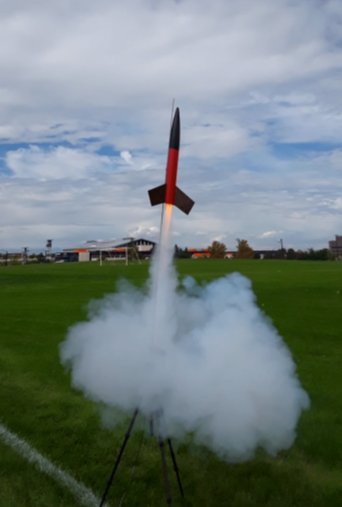 |
| With five A8-3's and two B6-4's blazing, the Mahogany Max roars off the pad for a low and slow flight. Ejection was at apogee, and the bird floated down for a perfect landing! |
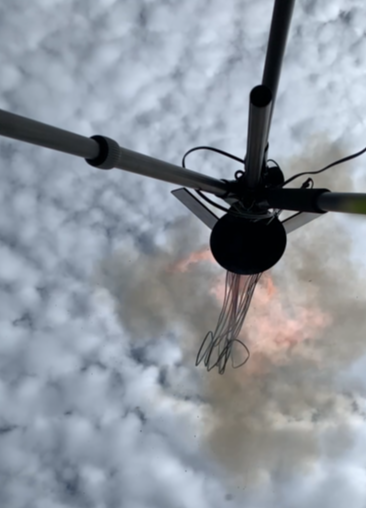 |
| A 'mole's-eye' view of the Max at ignition. Note the dispersion of the motor jet plumes as they hit the blast deflector. |
 |
| My Wasp boost/glider ready to go... |
 |
| A straight up boost on a 1/2A6-2 motor. The glider separated and flew very well. All was successfully recovered. |
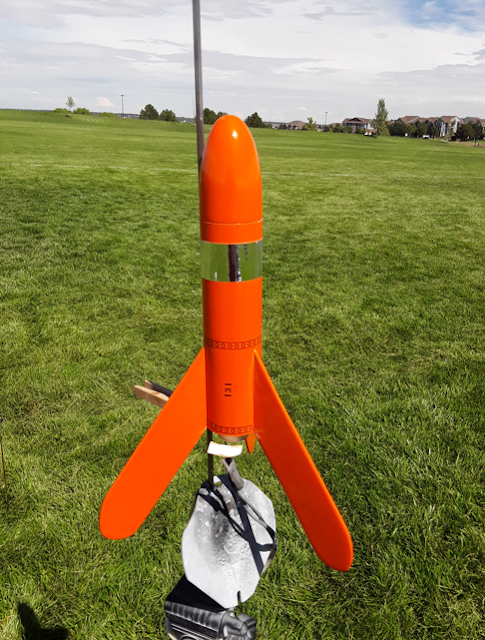 |
| Next up was my upscale Mosquito, the 'Skeeter Eeter 3'. Flying on a C11 motor the bird leapt off the pad and reached a respectable altitude. The model fell to the ground without a deployed parachute. |
 |
| To my amazement, the bird had stuck a perfect 3-point landing on its fins ! Step back, SpaceX !! The parachute can be seen jammed inside the nose cone. |
 |
| Darryl is seen here launching his Estes Goblin on a D12-5 motor while Lee and myself look on. The attractive bird turned in a spectacular flight! (Image by Brock Wood) |
 |
| Another view of the Goblin's liftoff. |
 |
| Apogee at around ten feet or so altitude.... |
 |
| ...and ejection on terra firma ! This flight was voted as the most amusing of the day! Fortunately, the ladies survived with no damage, and would see another flight very soon. |
 |
| Gosh, but I had so much fun launching the Interceptor earlier, I thought another run was in order. |
 |
| The start of another textbook flight on a C6-5 ! (Image by Brock Wood) |
 |
| Here we have Brock's 'Renewed Mongoose' two stager, ready to launch on a B6-0/A8-5 combo. |
 |
| Brock got this interesting shot of the model's liftoff from a video taken beneath the launcher |
 |
| ...and liftoff from a different perspective. The model turned in a perfect flight and was successfully recovered. |
 |
| Jim with his inverted-fin Alpha upscale and booster. This model was inspired by a design by 'Lakeroadster' in a TRF post. |
 |
| The unique booster stage is a ring fin design with cutouts designed to induce spin recovery. |
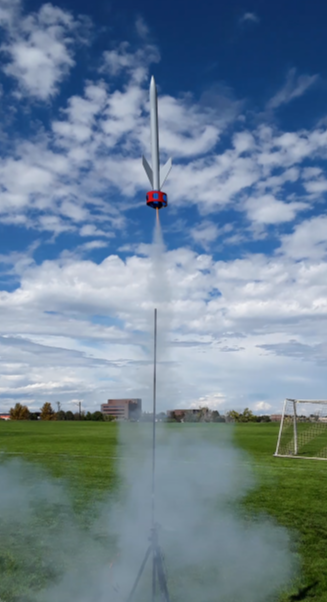 |
| Liftoff on a gap-staged D12-0 / C11-3 stack. The model weather-cocked and didn't get high enough to allow the booster to transition into a spinning motion. The upper stage sustained a broken fin on landing. |
 |
| Next up was Darryl's second launch of his ESAM-58 on a C6-5 motor. (Image by Brock Wood) |
 |
| A picture-perfect flight and recovery! |
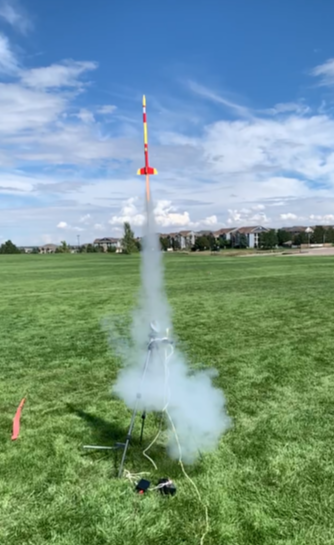 |
| The start of a perfect flight on a core A8-5 and an A10-0 in each of the side pods. |
 |
| Lee soon had his Bertha and Betty prepped and on the pad. This time the pair turned in a spectacular flight on two C6-3s. |
 |
| After a liberal amount of CA, Jim had his big two stager ready to go again. Flying on E12-0 / C11-3 power, the model turned in a much better performance. |
 |
| Here we have Brock's Custom Rocket Company 'Aztec' upper stage ready for flight. |
 |
| Liftoff for a great flight powered by a B6-4 motor. |
 |
| My final flight of the day was turned in by the Cherokee /Icarus 2-stager. Motors used were a D12-0 gap staged to a C6-7. The model carried an 808 video camera. |
 |
| The final flight of the day went to Lee's Halloween Bowl odd-roc. This time it was powered by a mighty E12-4 for a great flight! |
 |
| Guest Adam Wesorick from Castle Rock stopped by to enjoy watching a number of the flights. |
 |
| I happened to snap this photo of a cool looking thunderhead anvil forming off to the east of Denver. |
 |
| Two birds with one shot... This was taken from a frame of Brock's ground-view video of his Aztec flight. As the model neared apogee, a real bird flew into camera range right above the launcher! |
 |
| VERY old school ignition technology. All three of Brock's launches this day were started with ignitors fashioned from 28-gauge bare nichrome wire, looped and held in place with tamped wadding. Not a misfire in the lot ! Cheers! |